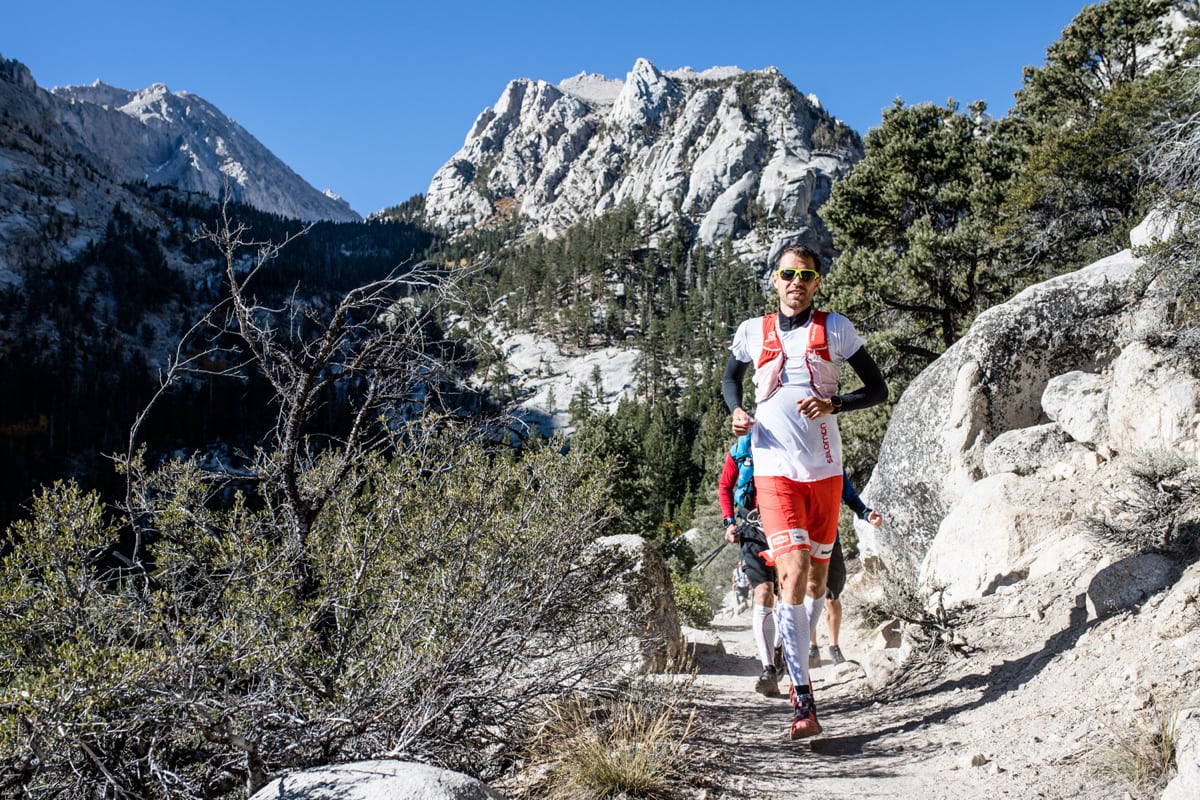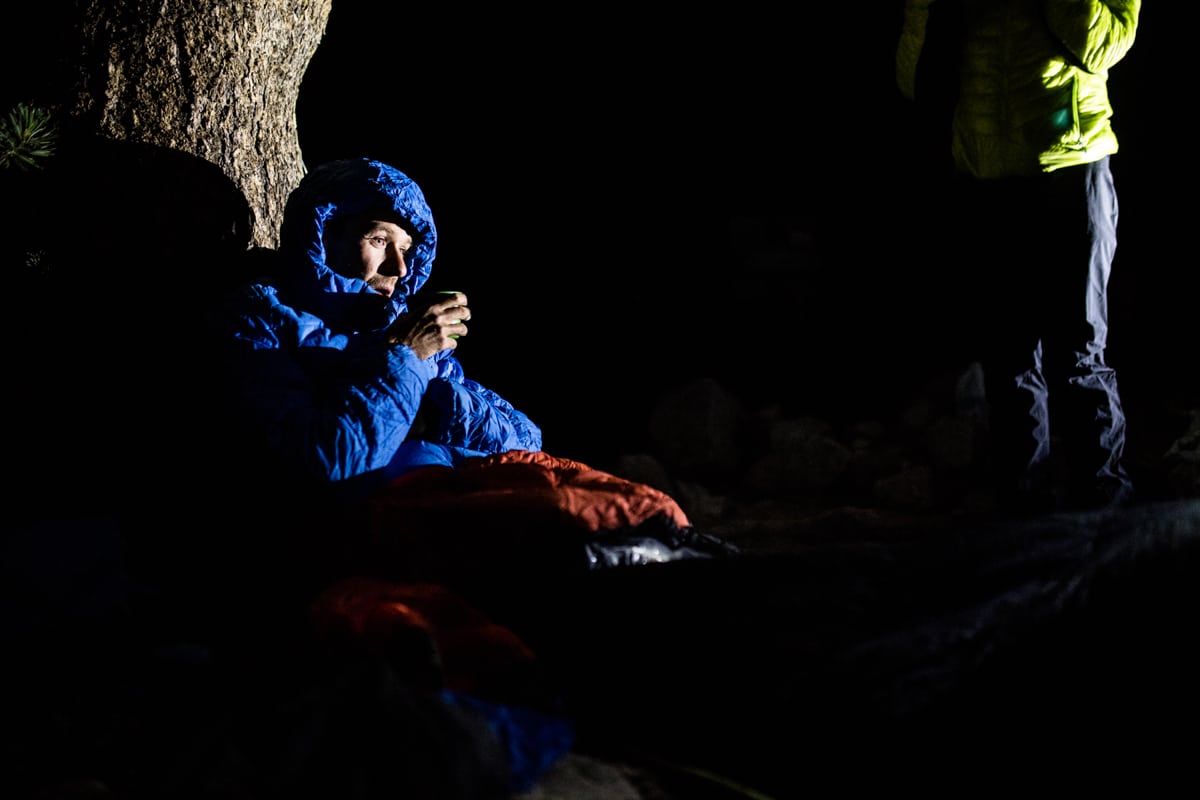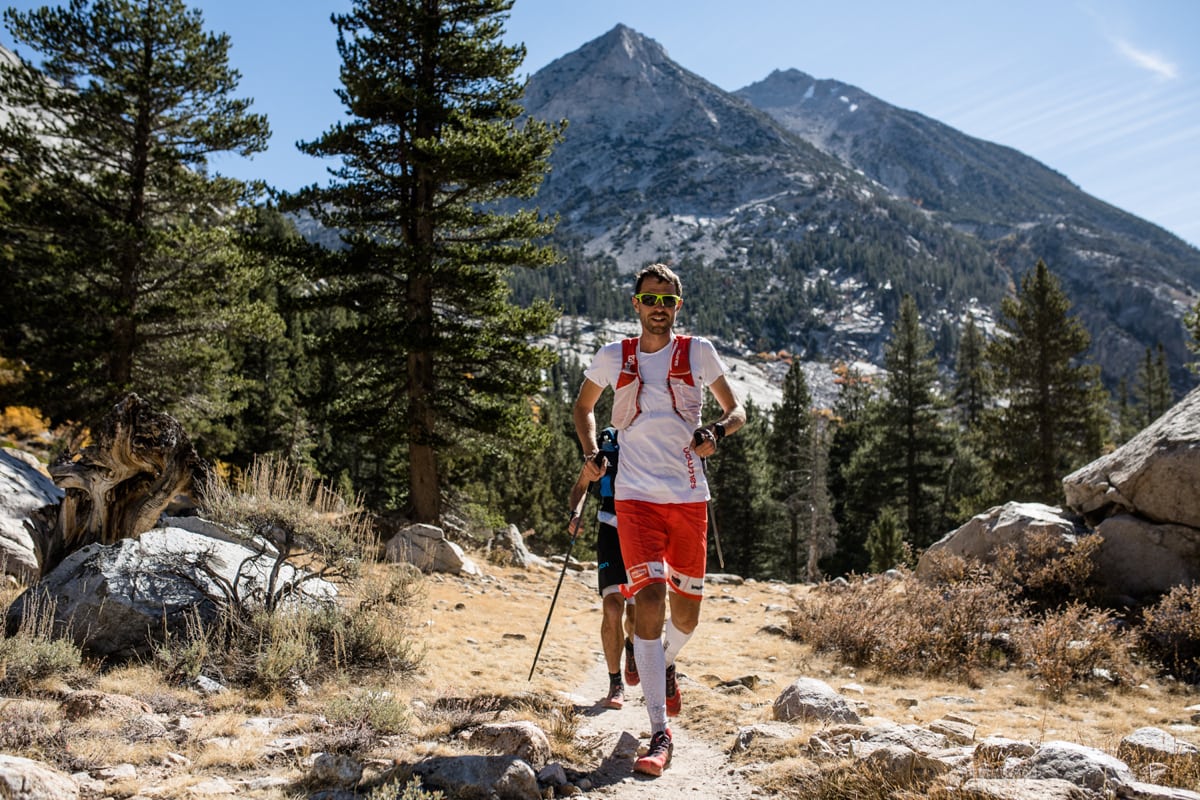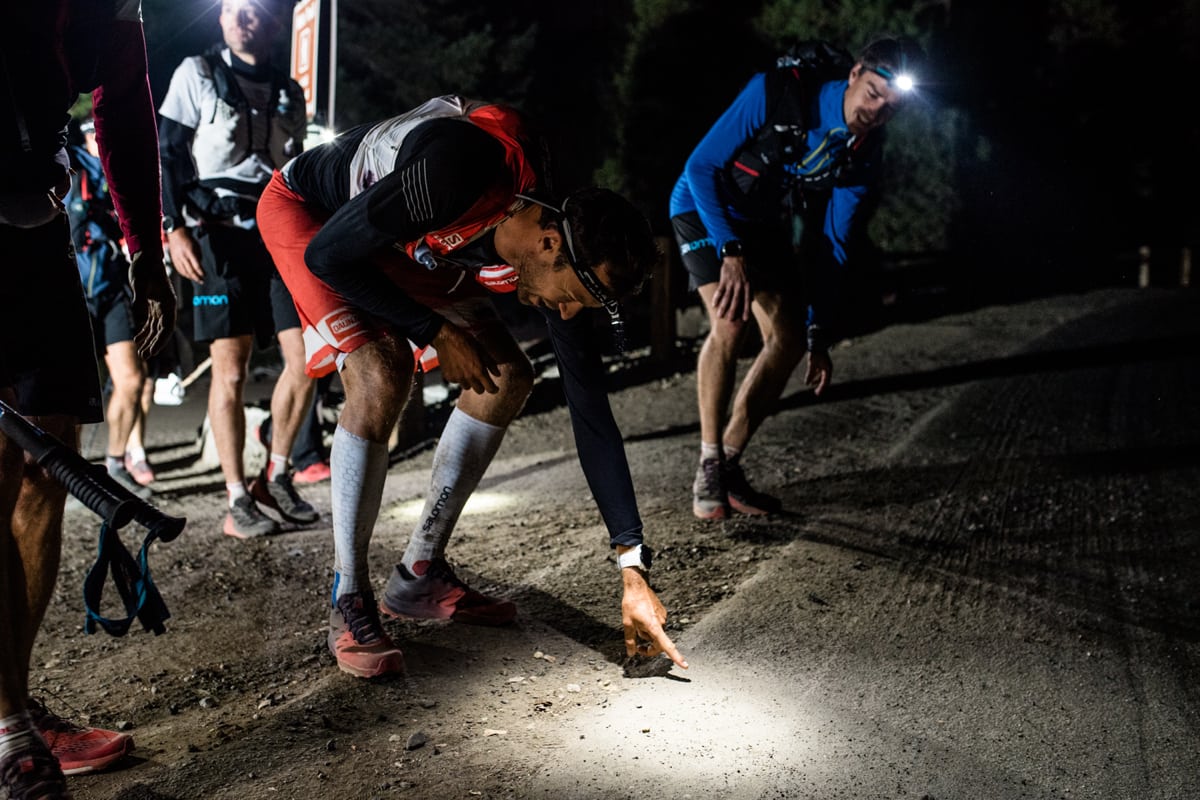In October 2017, François D’haene reset the supported fastest known time (FKT) for the 223-mile John Muir Trail in California’s Sierra Nevada at 2 days, 19 hours, and 26 minutes, an improvement of more than 12 hours on the previous record and in a time that dips way below the three-day barrier. The previous supported FKT was set in 2014 by Leor Pantilat at 3 days, 7 hours, and 36 minutes. In this phone interview, conducted five days after his effort, François talks about why he set his sights on the John Muir Trail, how wild the route is, what new things he learned through this ultra-long effort, and if he thinks he’ll adventure in the U.S. again.
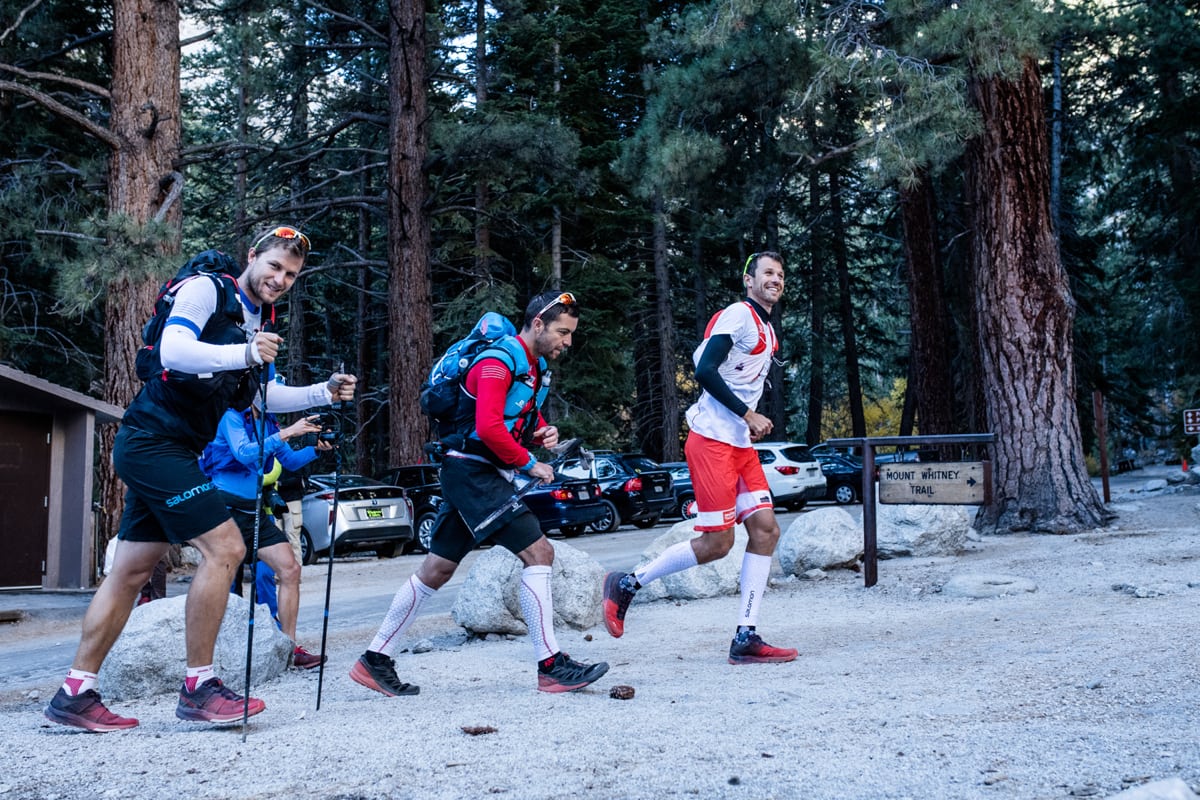
François D’haene sets off from the Whitney Portal, the southern side of the John Muir Trail, on his record attempt. Photo: Droz Photo
iRunFar: Congratulations! How are you doing?
François D’haene: I’m fine, tired, but I’m fine. I’m really happy to have a run like that.
iRunFar: You had an incredible run on the John Muir Trail. Have you had some good nights of sleep since then?
D’haene: Yes, the first two nights were really complicated, but now it’s a bit better.
iRunFar: I want to ask you about how you learned of the John Muir Trail. How did you discover it for the first time and decide you wanted to do the trail?
D’haene: After the GR20 in Corsica, we decided to make something new with my friends, with the same team. We wanted to discover some new places, some new adventures, new ways, new limits of the body, and maybe something more long and intense—something new. Then I started reading some books, and I saw the John Muir Trail. The distance looked good, and everybody said it’s one of the best trails in the world. Then I emailed some people like you and Bryon [Powell] and other American runners and they all encouraged me. They said they thought it was a most beautiful trail and I should do it. Then we started to organize it. Step by step we got organized, and it was really, really nice.
iRunFar: It seems like you are pretty meticulous in the way you plan for your events. You do very structured training blocks. You organize details very thoroughly. What was it like trying to organize all the details for such a long trail so far from home?
D’haene: It was hard to organize something in the USA. It was hard to get permits. It was hard to know if we could do it or take pictures or some things like that. It was tough to organize the travel for all the people and to rent a camper van. Then when we arrived in San Francisco, we went directly to the mountains to try to see the John Muir Trail. It was unbelievable. We’d planned on a four-hour drive, but it was a 12-hour drive. There were no markers on the trail, it was a very small track, most of the trail was really wild with no one on the trail. But it’s what I like. I really like that. I think it was a little bit difficult for my friends. Then during all the week, we tried to organize some different parts because of Peter Bakwin from the FKT website, he sent us some emails to say we had to be careful of this part and this part and this part and this part because you can lose your way on these parts. So we tried to organize these different parts from this conversation. We tried to organize all the different access points and junctions for all the pacers. During all the recce, it was just, “Wow, it’s so beautiful!” I was a little bit tired, but when I saw the trail and how it was so beautiful—we were not sure how it could be so nice—we were all really motivated.
iRunFar: When you got to California and you spent that week organizing and seeing the trail—not a lot of markings, no signs at some trail junctions, so remote, not a lot of people—did that make you nervous or excited or both?
D’haene: I was really happy to see it was really wild and not a lot of people because when they say there’s permits and maybe you won’t have it and maybe there will be too many people, I was afraid it wasn’t really wild and very used. But when we arrived, wow, it was true. It was really natural and it was really wild. Finally, it was incredible to be able to run more than 200 miles and never cross a road. You just see one time a forest road. It’s incredible. You are always on a singletrack for more than 300k. It’s crazy.
iRunFar: When you are on the John Muir Trail, you spend a lot of time in what America designates as a “wilderness,” which is our highest level of protection for land. When I talk to Europeans who come over and run through our wildernesses, they’re always very surprised how truly wild it is. When you get back to France and people ask you, how will you describe the difference between American wildernesses and places in Europe?
D’haene: For me in my mind, I already know that. I try to convince people that the U.S. is not like what it seems because people think it’s big cities and that everything is very connected. They don’t think about the wild space. The first thing they think about the U.S. is not about wild space, but for me it’s not like that. For sure I will explain to them how wild it is. The [European] Alps are really beautiful; they are very big. If you go into the Alps, it’s very long. You can never imagine the atmosphere when we are on the summit of each peak and on the John Muir Trail. You can see no lights, no cities, and no people. In France, even if you are on the top of Mont Blanc, if you turn your head, you can see some cities and some lights. On the John Muir Trail, it’s totally wild. If you break your ankle, you have to walk 50k to touch the road, but there’s nobody at the road. You have to be careful. I think it’s a real adventure. And everywhere in the U.S. is the same, I’m sure, because we went in the camper van and I say, “Okay tomorrow, we go to a big campground and there will be showers.” And then we arrive in Red’s Meadow and there’s nothing. “Okay tomorrow we will arrive in Tuolumne Meadows and we will have a restaurant and a coffee.” And there is nothing! Each day was the same, but that’s what was really great. Yes, it’s good to know there is some big landscape where there is nothing.
iRunFar: That’s funny. “Tomorrow we will have a shower and a coffee.” “Nope, not tomorrow either.” I want to ask you about your logistics of being on the trail. In following your tracking beacon, it looked like all throughout your time you were just steadily chipping away at the previous FKT. It didn’t look like any particular section you were going too much faster or too much slower. The trail itself has lots of different characteristics—very high terrain, very rocky terrain, some meadows down low or valleys you can run through. Did you feel pretty steady the whole time?
D’haene: Yeah, it was really like you say, it was really different, because sometimes it was really rocky and really technical, sometimes it was even icy and snowy, and sometimes it was just meadow and you could run fast. This is what I think I like with trail running because it’s never the same. It was really different from the first part to the last part on the John Muir Trail. Sometimes it was steep and sometimes it was not as steep. It was really different on the passes. I try to keep the same effort for all the trail. Sometimes when it’s rocky you go slowly, and sometimes it’s easy to run and you go faster. I tried to manage my effort and to give the same pace all the way.
iRunFar: One of the challenges of doing something that’s so much longer than a 100-mile race that you have a lot of familiarity with is figuring out the pace you can maintain the whole way, figuring out how to rest and when to rest. This distance was a new experience for you. How did you plan those things, or did it come more organically as you were feeling it out there?
D’haene: I really wanted to discover something new with me and with the others. The first day it was hard to find the pace. I tried to go slowly. I said, “Okay, I have three days, not just one day.” I had programmed some rest places to sleep or to eat or to sit down, and I didn’t know how I would feel after that because I’ve never stopped for one hour or two hours or three hours. I was wondering what could be the benefits of stopping. Then after 10 hours, near Onion [Valley,] near Kearsage [Pass,] somewhere like that, my friends met me with some hot soup and some sandwiches, and I sat for 45 minutes. When I arrived, I was a little bit destroyed in my feet and some things. I changed my clothes, I slept 10 minutes, I ate, and when I started again, I felt like new. I thought that maybe I could have a normal UTMB pace—like not a faster ultra but a slow ultra. I was walking every ascent and taking time. I really wanted to be able to run until the last meters on the flats and the descents if it’s possible because I know there are long, long, long flats and long descents. My main goal was to be able to run until the end on these spots. I just kept that in mind. When I could stop, I’d stop and sleep 20 minutes, 10 minutes, or sometimes one or two minutes. It was really interesting to know I would be refreshed.
iRunFar: You took one longer break, I think I saw on your social media, after two days at Red’s Meadow. You took your longest break, right?
D’haene: Yes, I think it was the most difficult part for me because I’d had a very long and hard night arriving in Red’s Meadow, and I still had 100k to go. But it was nice because Tim Tollefson, he came there, all my friends were there. I ate some eggs and bacon, I sat one hour and a half, and I said, “Okay, you have all the day to go to Tuolumne Meadows, and then we will finish all together.” I said, “It’s like a long walk. You can touch it.” It was I think the worst time for the mental side. It was really hard to know that it’s still 100k to go.
iRunFar: Converting from running UTMB just a little over a month before doing this, I think many people would not be able to recover as fast as you did. Do you have any thoughts on your recovery from UTMB?
D’haene: I think what was good is because after UTMB, three days after, I was already at harvest in my winery, and we were 50 people at home. You have to take care of them, make food for them, you have to do really hard work. With the grapes, it was hard too. During 10 days, I was not able to think about trail running. It was totally out of thought. Even after UTMB, I made a party and spoke about it sometimes, but I was really focused on the winery. I don’t think I thought about trail running. When I got back to thinking about trail running, it was, Oh, yeah, cool. Maybe I’d like to put my vest on again and something like that. I’m sure if I had not this winery, my recovery wouldn’t be the same because 10 days after UTMB you don’t want to wear the vest again. Because I was doing something very different and something else, I think my recovery was good. Then because of this project being totally different than an ultra, it was really a collective and creative thing, I was really motivated about this project.
iRunFar: The experience of being out on the John Muir Trail for the time you were, you must have something you’re going to remember for a long time—an encounter with wildlife or the night or something. Can you share a story?
D’haene: I think it’s been something for me that I picked a project that is so big and with so many friends so far from my house. For sure I’ll remember it for such a long time. Yeah, it’s really nice because it’s nice memories for sure, but it’s opened for me some perspective, because I understand if you rest for two or three hours then the body can go again and maybe you can go for a long time. It’s incredible to see I can run 350k. Ten years ago I never would have imagined. It’s opened some perspective because now it’s not one week after and even three days after, I can walk like normal. I’m really tired, but I have no big pain and no injury. It’s so cool to have this understanding.
iRunFar: The world becomes even bigger?
D’haene: Yeah.
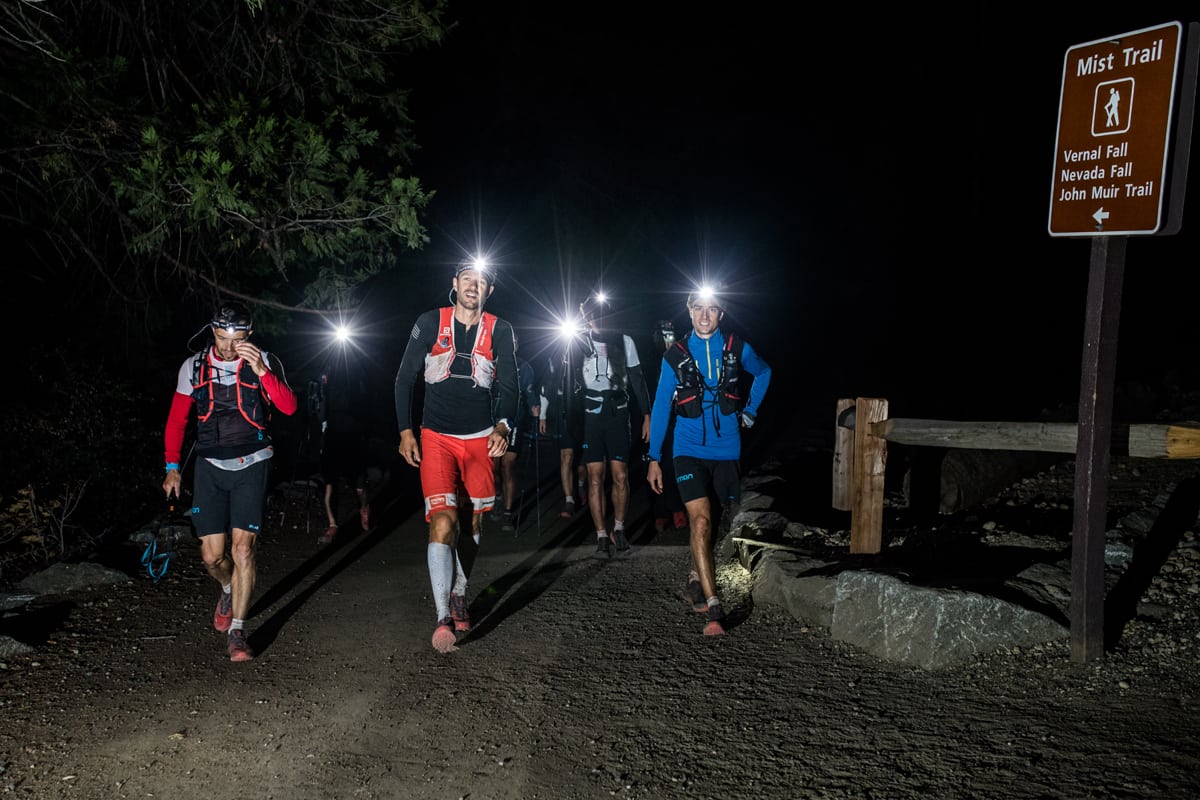
François and his support team arriving to the northern end of the John Muir Trail in Yosemite Valley in record time. Photo: Droz Photo
iRunFar: You’ve been away from home for about two weeks, and you’re just about to jump on a plane to go to your family. You must be excited.
D’haene: Now, my wife is coming with my children to the U.S. I join them in San Francisco, and we stay in the U.S. until the fourth of November.
iRunFar: Now you’ll have a family vacation?
D’haene: We will make a road trip. We will drop the camper van in Las Vegas on the fourth of November. Yeah, I think the children were really sad without me. We will have two days in San Francisco. I think it will be perfect, and I will really enjoy this holiday.
iRunFar: That sounds fantastic. My last question for you, have you looked at some of your dreams or made any plans for 2018?
D’haene: Some new dreams? I don’t know yet. Yesterday I was in Boulder, Colorado and it was funny because there were many, many athletes there like Scott Jurek and Anton [Krupicka] and Joe Grant and yesterday afternoon we made a beer mile. It was really funny.
iRunFar: You did a beer mile?
D’haene: It was so nice. Yeah, we spoke a lot about what are the possibilities in the U.S. They say it’s just infinity. I really liked how it was wild here. For sure I will try to find a new project in the U.S. For sure my friends will be happy about that because it was an incredible week for us. I don’t know when, but I’m sure we will plan something here.
iRunFar: Very cool. I love that you did a beer mile.
D’haene: It was an ascent beer mile at Joe Grant’s place with 200 meters elevation gain. It was really nice. There were 25 participants, so it was really, really nice.
iRunFar: Fantastic. Thanks for your time this morning. I appreciate it.
D’haene: You’re welcome.
